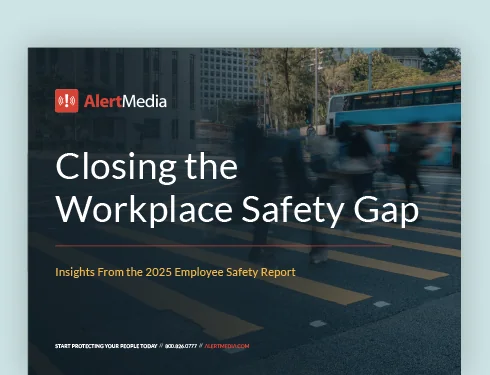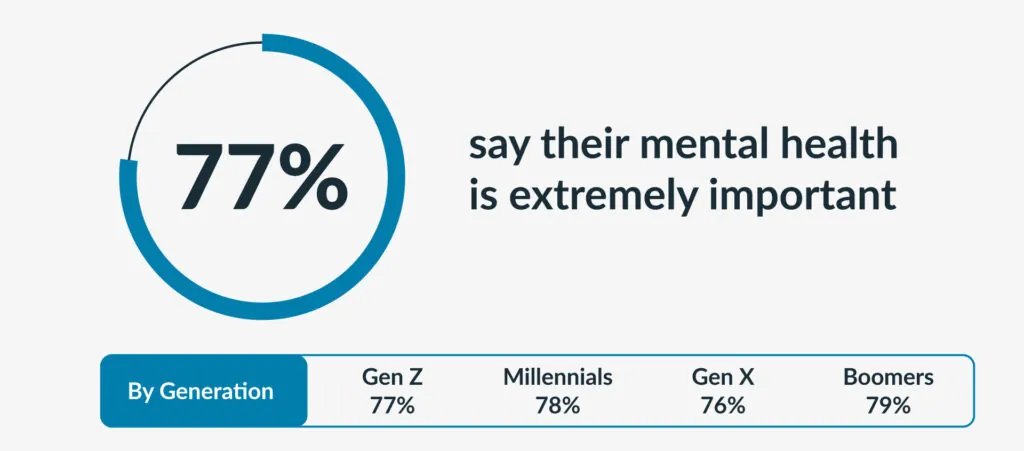
How to Prioritize Mental Health in the Workplace
Mental health struggles are often silent and sometimes deadly. Show your employees you care about their holistic health and keep your business at peak performance with a comprehensive employee mental health program.

Most U.S. adults have had to work through illness or injury at some point in their careers. It might have just been something minor, maybe a bout of allergies or a pinched nerve in your neck. Distracting pain that’s constantly tugging at the edges of your focus. For others, it might be something larger, like a major illness that casts a heavy shadow over your mood and demands attention during the workday. While the scope of burden will vary drastically depending on your unique struggles, at every level, your health is going to impact your job.
It’s easy to point to something like a broken leg or the flu and say, “This is going to slow me down at work.” After all, you can’t leave your physical ailments at home. But there are many other conditions, much less visible, that also affect employees’ health, safety, and performance at work. Mental health challenges are more common than many people realize—and more likely to go untreated and unsupported in the workplace.
Download the Employee Safety Report
What Is Mental Health?
Mental health consists of a person’s social, psychological, and emotional well-being and considers factors like stress management, decision-making, and thought patterns. Mental health can greatly impact any individual’s quality of life, and poor mental health can create lasting detrimental effects if not addressed.
Mental health, just like physical health, encompasses a huge range of considerations. And though it’s not easy to see at first glance if someone is struggling with depression, anxiety, or another mental illness, it doesn’t mean employers should assume their employees are fine.
A new era of workplace health and safety
Talking about mental health in a work environment has historically been taboo—after all, no employee wants to seem as if they can’t handle their workload and risk losing their job. But there is a growing effort to destigmatize these conversations to build a better culture of wellness. And businesses must go beyond mere talk to put support networks, resources, and benefits in place, so their employees are cared for.
While mental health might not be discussed in workplace safety circles as much as visible risks like accidents or injuries, it is just as important to prioritize. And there is no better time than now to focus on mental health. The wake of the pandemic has prompted many employees to reexamine their priorities in the workplace, and many are still struggling with the stress and emotional impacts of the last several years.
Even before the pandemic added unique pressures, a population of workers has always been fighting to compartmentalize their often-invisible struggles with depression, anxiety, and other mental health disorders. One positive effect of the pandemic was that it threw this issue into stark focus and partially destigmatized the discussion of mental health in the context of work.
Addressing mental health in the workplace is no longer optional. And yet, according to our 2023 State of Employee Safety Report, only 33% of employees believe they can openly discuss their mental health in the workplace. Unaddressed mental health concerns can have major implications for the health of employees and the overall function of a business. This article will break down those implications and what companies can do to help.
Why Prioritize Mental Health at Work?
All businesses have a duty of care to protect their employees from harm while working. This goes for traditional workplace safety efforts like providing PPE and training for dangerous equipment usage, and it also covers protecting the mental health of your workers.
Percentage of employees who consider their mental health “extremely important”
The importance of mental health problems and mental illness cannot be overstated, with over 77% of workers saying that their mental health is “extremely important” to them. By contrast, only 45% of those same workers believe that their employers share those concerns. There’s clearly a large portion of the working population that thinks their company isn’t doing enough to offer mental and emotional support, even though mentally healthy workers perform better.

Poor mental health can affect:
- Productivity
- Job performance
- Communication skills
- Teamwork
- Engagement
- Job satisfaction
- Employee retention
- The bottom line
Mental health can also have financial impacts since companies spend an average of $15,000 annually for employees facing mental health issues, although there is evidence that there is a high return on investment for spending on mental health programs. Additionally, unwell employees often face increased absenteeism and require more time off—some report missing up to eight days of work.
Just like their physical health, an employee’s mental health doesn’t only exist while they are outside their regular 9–5 hours—there is simply no way for people to stop feeling the effects of stress, anxiety, depression, or more while at work. In fact, work-related stress can often exacerbate mental health conditions. Nine in ten employees report that their workplace stress impacts their mental health, and three in five say they are not receiving adequate support from their supervisors to help manage stress.
For employees who don’t feel supported by their organization, attrition is a common consequence. Fifty percent of employees have left a role for mental health reasons, and that rate is higher—up to 81 percent—for Millennials and Gen Z. This supports research that shows employees are more likely to leave a job when they feel their safety is not prioritized by their employer. Employers are facing a workforce that is significantly more concerned about safety, mental health included, and the stakes are high for losing key team members.
The stakes are much higher, however, for employees struggling with suicidal thoughts. Incidences of suicide are climbing, recently reaching a 50-year high, and Forbes reports that workplace stress, combined with substance use, is believed to be the leading factor in suicides when employees have little or no control over high job demands.
“When you’re concerned that a person may be suicidal, you should look for a change in their behavior or the presence of entirely new behaviors. This can especially be of concern if that new or changed behavior is related to a painful event, a loss, or change. Most people who take their lives exhibit one or more of these warning signs, and it’s typically either through what they say or what they do.”
—Maggie Mortali, Senior Program Director, American Foundation for Suicide Prevention
How Does Mental Health Impact Other Safety Initiatives in the Workplace?
Mental health can also have major implications for other safety initiatives since a culture of safety requires all employees to contribute. Disgruntled or stressed employees who don’t feel supported for their mental health are less likely to follow proper safety protocols and are more likely to ignore important internal communications. Poor mental health symptoms, like bad sleeping and eating habits, are risk factors for dangerous behavior, like falling asleep at work. It can also inhibit comprehension of safety procedures, leading to a higher rate of accidents.
Poor communication is also a risk for employees suffering from mental health concerns. Communication is a critical facet of workplace safety, and any missing link can cause a large-scale breakdown. This is especially true during emergency situations, where every second counts.
Businesses have a huge influence over their employees’ well-being, and it is an employer’s responsibility to ensure that their employees are protected.
How Employers Are Supporting Employees’ Mental Health
There are a lot of examples of how you can support mental health in the workplace. For one, Zendesk, a sales and support CRM business, partnered with Modern Health, a global preventative mental wellness platform, to provide self-service wellness kits, coaching, and therapist-matching services to their employees.
Companies like Bumble, LinkedIn, and HubSpot have opted to support their employees’ mental health with time off. These companies offered up to a full week of paid time off to employees for a “burnout break” or a “week of rest” to combat stress and overwork.
Companies taking action understand that mental health is a priority, not only to improve the well-being of their teams but also for the smooth operation of their businesses. But there is still work to be done. On The Employee Safety Podcast, sociologist Dr. Tracy Bower recommends a few ways employers can boost support for employees’ mental health:
- Provide access to mental health apps
- Contribute to the care of employees’ loved ones and even pets with access to Care.com or other services
- Facilitate “affiliation groups” where those struggling can gather for support
- Encourage greater interaction with nature
While large-scale efforts like time off for mental health or fully funded mental health apps sound great, it’s not always possible for every business. But there are other actions you can take.
10 Tips for Mental Health Management
Mental health management is twofold, involving intention and action. You need to genuinely care about the mental well-being of your employees, and then you need to take concrete steps to help support them. But these steps don’t need to be giant, and they don’t need to be the same steps your competitor or any other business is taking. Here are some options you might consider to build out your mental health policies:
- Educate employees about mental health benefits — While people are talking about mental health more now than ever before, there are likely still some gaps in your employees’ understanding. Make sure your employees know how you are able to support them and what their options are if they need help.
- Assess your health insurance and benefits — What mental health services are covered? Ensuring your plans cover services like mental health screenings and therapy/counseling can be a huge help to employees who may be struggling.
- Include mental health time off in your paid sick leave or PTO plans — Your employees may not know they can, or may not feel empowered to, use their paid sick time or PTO for mental health reasons. Communicate the options and encourage them to use the time they need to rest and recharge.
- Offer short-term disability coverage — This can help employees struggling with acute mental health concerns who may need more time off than sick leave allows.
- Consider employee assistance programs (EAP) — EAPs can provide free counseling, assessments, referrals, and follow-up services for employees outside of their normal health coverage.
- Train managers and leadership on how to identify struggling employees — Arm supervisors with information and training on how to help co-workers. This is especially important because mental health issues are often covered by ADA protections, meaning employees may require reasonable accommodation and cannot be fired over their illness.
- Include mental health in your day-to-day communications — By promoting mental health with your employees regularly, you encourage more open and transparent dialogue and can more easily spot employees who may be struggling.
Effect of formal discussions of mental health by employers on their employees’ comfortableness in discussing mental health issues with their supervisors

Source: SN Computer Science
- Promote physical health as well — Physical and mental health are very closely tied, so encourage both facets and discuss how you can continue to integrate support into your company culture.
- Emphasize a healthy work-life balance — Implementing a good work-life balance means employees have better boundaries so work stressors are less likely to affect their personal lives and vice versa.
- Encourage breaks during the day — Frequent, small breaks can provide space for self-care and limit the amount of stress that accumulates for employees.
Whatever shape your plan takes, regularly communicate how much you care for your employees. You want them to know that all facets of their health and safety are a priority to you. They should also know exactly what options and services are available to them and how to access those services—in times when they are struggling as well as proactively.
A Healthy Business Needs Healthy Employees
Mental health is one of the most pervasive and impactful health issues facing today’s workforce. It’s critical that employers understand the implications and know how to talk about and address them within their own businesses. The more an organization is committed to building a mentally healthy workplace, the more people are going to feel encouraged to get help. In this way, caring for employees and caring for the business go hand in hand.




